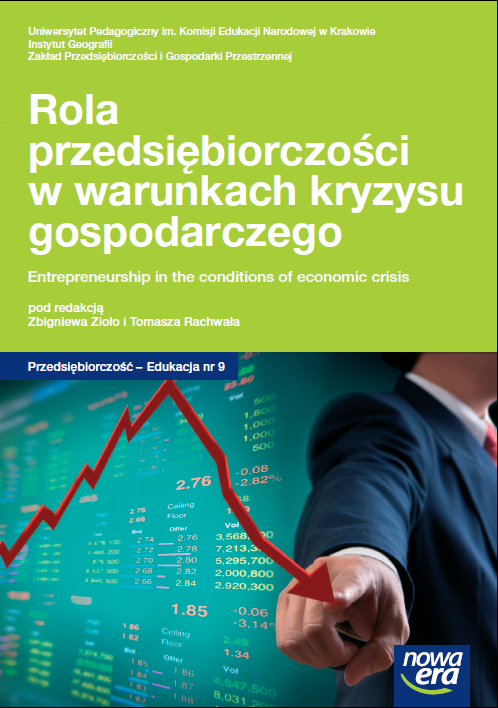Technology of constructing cheap, energy-efficient house as an answer to the housing industry crisis
DOI:
https://doi.org/10.24917/20833296.9.14Keywords:
, economic crisis, energy-efficient and passive housesAbstract
The following paper discusses research, connected with innovative solutions in the field of cheap housing construction, relating to the economic crisis, noticeable also in the housing industry, in the form of rising costs of dwelling usage, due mostly to increasing prices of energy, in the aspect of the relatively low standard of housing in Poland. The technology of design and construction of buildings from frothed polystyrene (‘neopor’), presented in the following article, is an example of meeting the expectations of developers and dwelling users, by building houses which are less expensive to construct and maintain, in accordance with the requirements of energy-efficiency and passivity. The above is an example of innovative thinking, based not on improvements to existing building methods, but on the implementation of new solutions, which take advantage of modern materials (neopor), heretofore used only for purposes of insulation, and now being employed as a construction material. The method described in this article is not only a theoretical idea, but one that is being currently realized, in the form of buildings constructed from prefabricated neopor elements in the Małopolska region. Erecting these buildings, using the above-mentioned method, was cheaper and faster, compared to the traditional manner. Similar undertakings should be expected in the future, due to demand for low-cost housing in the period of crisis, and as an expression of the innovative potential of Polish engineers. Of course, such innovative solutions require the breaking of certain barriers of stereotypical thinking, connected with ‘living in polystyryne foam’, as well as a dose of flexibility from users of future neopor houses. However, benefits of applying such an innovative technology, presented in the article, will certainly lead to its implementation. In the future, the most important issue seems to be the development of cooperation between scientists and entrepreneurs, especially in the areas of tests and evaluations of new materials and technologies.References
Fedorak-Cisak, M., Furtak, M. (2012). Małopolskie laboratorium budownictwa pasywnego, Czasopismo Techniczne, Budownictwo, 3(109).
Gorzelak, G. (2009). Geografia polskiego kryzysu. Kryzys peryferii czy peryferia kryzysu? Warszawa: Regional Studies Association – Sekcja Polska.
Kasperkiewicz, K. (2005). Wybrane zagadnienia oceny i projektowania energooszczędnych budynków mieszkalnych, Prace Instytutu Techniki Budowlanej, 2 (134).
Kozik, R., Starzyk, E. (2011). Wpływ światowego kryzysu gospodarczego na polski rynek zamówień publicznych na roboty budowlane. Budownictwo i inżynieria środowiska, 2 (2011).
Rachwał, T. (2011). Wpływ kryzysu na zmiany produkcji przemysłowej w Polsce, Prace Komisji Geografii Przemysłu Polskiego Towarzystwa Geograficznego, 17, 99-113.
Repelewicz, M. (2011). Styropian jako materiał konstrukcyjny, Czasopismo Techniczne, Architektura, 11(108).
Węglarz, A., Stępień, R. (2011). Dom pasywny. Warszawa: Instytut na rzecz Ekorozwoju, przy współpracy Krajowej Agencji Poszanowania Energii S.A.
Dyrektywa Parlamentu Europejskiego i Rady 2002/91/UE z dnia 16 grudnia 2002 r. w sprawie charakterystyki energetycznej budynków.
Dyrektywa Parlamentu Europejskiego i Rady 2010/31/UE z dnia 19 maja 2010 r. w sprawie charakterystyki energetycznej budynków.
GUS (2012.10.15), Informacje bieżące, Warszawa.
Housing Europe Review, The Nuts and Bolts of European Social Housing Systems, 2012, 2011, CECODHAS Housing Europe’s Observatory, Brussels.
Rozporządzenie Ministra Infrastruktury z 6 listopada 2008 r. zmieniające rozporządzenie w sprawie warunków technicznych, jakim powinny odpowiadać budynki i ich usytuowanie (Dz.U. nr 201, poz. 1238 z późn. zm.).
Rozporządzenie Ministra Infrastruktury z 6 listopada 2008 r. w sprawie metodologii obliczania charakterystyki energetycznej budynku stanowiącej samodzielną całość techniczno-użytkową oraz sposobu sporządzania świadectw i ich charakterystyki energetycznej (Dz.U. nr 201, poz. 1240).
Downloads
Published
How to Cite
Issue
Section
License
Articles are published under the terms of the Creative Commons License (CC BY-ND 4.0; Attribution– NoDerivs).

